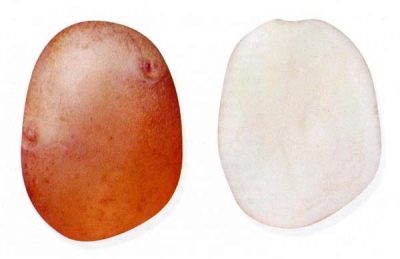
- Authors: Gadzhiev Nadim Makhish oglu, Lebedeva Vera Aleksandrovna, Ivanov Zinaida Zakharovna (State Scientific Institution Leningrad Research Institute of Agriculture "Belogorka" of the Russian Agricultural Academy, State Institution of General Genetics named after Vavilov, LLC Breeding firm "LIGa", LLC "Slavyanka-M", "GNU Kaliningrad Scientific Research Institute of Agriculture" ON Kholmogorsk experimental station of animal husbandry and plant growing.)
- Year of approval: 2001
- Appointment: dining room
- Tuber weight, g: 59-90
- Peel color: red
- Color of the pulp: white
- Starch content,%: 15,7-16,0%
- Tuber shape: oval-rounded
- Peel structure: smooth to medium
- Flowers: medium, reddish purple
Potatoes with the unusual name Bullfinch are known relatively recently. It has good taste and high yield, which is why the variety is gradually gaining popularity.
Breeding history
Work on the breeding of this variety began in 1998. Bullfinch was included in the State Register for the North-West Region already in 2001. A galaxy of scientists belonging to different institutes worked on its creation at once: N.M. Gadzhiev, V.A.Lebedeva and Z.Z. Ivanova.
Description of the variety
The potato belongs to 6 types of hybrids. The bush reaches a medium height.
Characteristics of the appearance of the bush and root crops
Bullfinch belongs to intermediate varieties, erect and semi-erect. It has large green leaves without wavy or slightly wavy edges. The flowers are medium-sized, reddish-purple in color.
The number of tubers per bush reaches 11-15 pieces. The mass of one potato is 59-90 g. The oval-rounded tubers have a smooth, red skin and white flesh inside.
Purpose and taste of tubers
The variety has a purely table purpose. Tasters describe its taste as good and excellent. The bullfinch belongs to the culinary type BC, is moderately boiled, contains starch, in a percentage of the total mass from 15.7 to 16%. Possesses high keeping quality. It reaches 95%.
Maturation
In terms of ripening, it belongs to the early ones. The period from germination to harvesting lasts 80-90 days.
Yield
The variety is high-yielding. The average indicator is 180-271 c / ha. The maximum yield can reach 354 c / ha. Bullfinch also pleases with indicators of marketability - 65-85%.
Growing regions
In addition to some Belarusian regions, in which Bullfinch appears occasionally, most often it can be found in Russia.
Regions for growing potatoes are prescribed:
northern,
Northwestern,
Central,
Volgo-Vyatsky,
Central Black Earth,
Middle Volga,
Uralsky,
Far Eastern.
Growing and care
In general, Bullfinch is unpretentious in planting and in terms of conditions, however, it has a number of its distinctive characteristics. Considering them, you can grow a good and tasty harvest.
Disembarkation is carried out in the spring, in the holes. Before this, the tubers are selected and prepared:
Damaged, underdeveloped and too large tubers are harvested.
For 3-4 weeks, the remaining tubers are placed in a box in a dry, well-lit and warm place. Adequate gardening is considered as such when the shoots reach 2-3 cm. It is important that they are thick, since the filamentous shoots give a weak and reduced yield.
For 3-4 days, potatoes are treated with growth stimulants. Gardeners do not recommend using special sprayers for pests and diseases, citing their non-environmental friendliness. But dusting with humatized preparations, based on wood ash, is considered a good action. There is 1 tbsp per bush. spoon.
Onion peels can be poured into the prepared holes, placed according to the scheme 60x30 cm (60 between holes and 35 between beds). The depth of the hole is on average 8-10 cm.
The first watering is carried out 7-10 days after germination.After long and heavy rains, watering is significantly reduced.
The bushes are abundantly watered during the periods of budding, flowering and the appearance of ovaries. The land should be irrigated either early in the morning or already in the evening.
The bullfinch also needs hilling: the first time the procedure is carried out when the bushes reach 10-12 cm.The plants are left at the height of the four lower leaves. The second time this happens when the bush reaches 15-20 cm.
With the first hilling, the fertilization period begins. Experienced gardeners recommend using complexes of nitrogen, phosphorus and potassium fertilizers. Bullfinch assimilates mullein and bird droppings just as well. The bush is fed, as a rule, after watering.
Organic fertilizers are applied in a liquid state. Previously, they are insisted for about a day. Their effectiveness, according to observers, is to increase the yield by 30-50%.
The proportions for mullein are 1: 10, for poultry droppings - 1: 15, where the first part is pure fertilizer, the second is water.

Planting potatoes is one of the main spring activities traditional for Russian gardeners. There are many ways to plant this vegetable, allowing you to get a good harvest in different conditions and climates. Before planting, you need to carefully prepare the planting material, correctly determine the timing, competently prepare the soil.


Soil requirements
The soil for this variety of potatoes is loose and fertile. Ideally, if nothing has been cultivated on it for a year or two.
If the soil is poorly aerated, it must be dug up or loosened. Digging, one way or another, takes place every autumn. A good saturation of the earth with oxygen contributes to the normal growth and development of the root system and fruits in general.

Disease and pest resistance
Like any other potato, Bullfinch has strengths and weaknesses.
Among the diseases to which the variety is susceptible are:
golden nematode,
late blight of leaves,
rhizoctonia (black scab),
viruses.
Among the diseases to which the bullfinch is resistant:
potato cancer,
late blight of tubers;
common scab.

Potatoes are a popular vegetable crop that many gardeners planted on their site. But growing a bountiful harvest of tasty and large tubers is unlikely to succeed if the beds are not properly protected from the most common diseases and pests. Often, the development of diseases of various etiologies of potatoes goes unnoticed, so it is important to identify the problem in time and eliminate it.
















































































